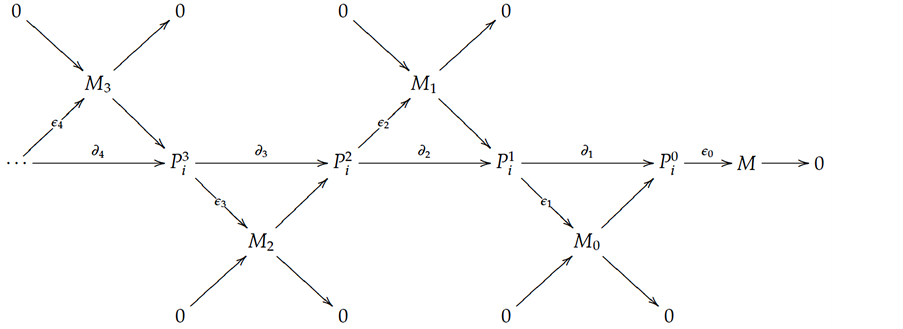Advances in Pure Mathematics
Vol.05 No.14(2015), Article ID:62177,6 pages
10.4236/apm.2015.514079
Stratification Analysis of Certain Nakayama Algebras
José Fidel Hernández Advíncula, Rafael Francisco Ochoa de la Cruz
Department of Mathematics, Havana University, Havana, Cuba

Copyright © 2015 by authors and Scientific Research Publishing Inc.
This work is licensed under the Creative Commons Attribution International License (CC BY).
http://creativecommons.org/licenses/by/4.0/



Received 27 October 2015; accepted 21 December 2015; published 24 December 2015
ABSTRACT
Our purpose in these notes is to present a result for a specific Nakayama Algebra. In essence, it affirms that for any order of simple modules, the cyclic Nakayama Algebras with relations  (i.e.
(i.e. ) are not standardly stratified or costandardly stratified.
) are not standardly stratified or costandardly stratified.
Keywords:
Standardly Stratified, Cyclical Nakayama Algebras, Infinite Projective Dimension

1. Introduction
The aim of this paper is to present a series of results obtained in relation to a particular class of Nakayama algebras. We will begin by recalling the fundamental notions and results of standarly stratified and almost hereditary algebras theory, which will be our main tool.
The concept of standardly stratified algebras emerged as a natural generalization of quasi-hereditary algebras. The class of quasi-hereditary algebras was introduced by Cline, Parshall and Scott in connection with their study of highest weight categories arising in the representation theory of semisimple complex Lie algebras and alge- braic groups.
We present our first result, which allows to obtain the main theorem of the article as an immediate con- sequence.
Theorem 1. Let L be an algebra, such that all non trivial quotient of indecomposable projective has infinite projective dimension, then L is not a standardly stratified algebra for any order of simple modules, unless  is the subcategory
is the subcategory .
.
Later, we introduce some notions of uniserial algebras and uniserial modules. In section 4, we introduce Nakayama algebras, also known as uniserial generalised Algebras that are studied by Tadasi Nakayama in [1] . In his short notes, as Nakayama called his publication, it was proposed to make some observations to his previous publication about Frobeniusians Algebras, whose first part was published in 1939 at Annals of Mathematics.
We conclude by presenting a special class of Nakayama algebras, for which is the main result of this paper that we quote below:
Theorem 2. There is no simple order of simple modules for which the cyclical Nakayama Algebras with rela- tions  (i.e.
(i.e. ) are standardly stratified or costandardly stratified.
) are standardly stratified or costandardly stratified.
2. Projective Dimension, Injective Dimension and Global Dimension
The following concepts will allow us to define the notions of projective dimension, injective dimension and global dimension; which we will be very useful in demonstrating the fundamental result of this paper.
Definition 1. Let M be an L-module. A projective resolution of M is a complex P whit  for
for  in
in 

where  is a projective module for
is a projective module for . It should also satisfy that the map
. It should also satisfy that the map  is an epimorphism and
is an epimorphism and .
.
It is possible show that being L a K-algebra, it follows that every  has a projective resolution in
has a projective resolution in
Definition 2. Let M be an L-module. A minimal projective resolution of M is a projective resolution of M such that



Dually we define concepts injective resolution and minimal injective resolution. Is possible also prove that if L is a finite dimensional algebra then all module in 

Definition 3. Projective dimension of L-module M is the number 
M of length n and M does not have projective resolution of length
Dually it has the injective dimension of a L-module M.
Definition 4. Let L be an finite dimensional K-algebra. The global dimension 

3. Standarly Stratified Algebras and Quasi-Hereditary Algebras
Let R be a commutative Artin ring and L a basic Artin algebra over R. As further we assume full subcategories of

The principal results of this section can be find in [2] - [8] .
Definition 5. Let L be a Artin algebra and 


1. 


2. 


In the following we consider that L denote an 

to 
Definition 6. Let M be a L-module. A normal series in M is a sequence of submodules

The number t is called the length of the series. The quotients 
of composition is a normal series whose factors are simple modules, i.e., a normal serie which can not be refined to another longest.
If X is a L-module, we denote by 


For


Definition 7. Standard module












Note that the above definition implies that 





Definition 8. An algebra L is said standardly stratified if

Note that if L is standardly stratified the projective modules are in


The following example will allow us to understand the theory discussed above.
Example 3.1. Let L be the algebra given by the following quiver whit relations
We have to:





It is not difficult to check that this algebra is standardly stratified and costandardly stratified only at orders for respective simple modules given below:
1. To order 

2. To order 

We denote by 

Proposition 3. Let L be an standardly stratified algebra, then
The following theorem is the first result that present us in this paper. It will allow us to obtain, as an immediate consequence, our main result.
Theorem 4. Let L be an algebra, such that all non trivial quotient of indecomposable projective has infinite projective dimension, then L is not standardly stratified algebra for any order of simple modules, unless 

Proof. It’s clear that




4. Nakayama Algebras
Throughout, L is assumed to be a finite dimensional K-algebra, defined over an algebraically closed field K.
The principal results of this section can be find in [1] [9] [10] .
Definition 9. Let M be a L-module. Radical series M is defined as follows:
We agree to denote by 
We can define inductively soclo series for module M as:
where 
We denote 
Note that if


series M is finite. How


We can observe that


is finit.
Proposition 5. Let

Definition 10. Let

Is necessary introduce new notion for define the Nakayama Algebras.
Definition 11. Let M be an L-module. We say that M is uniserial if M possesses exactly one composition series.
Lemma 4.1 Let M be an L-module. Next conditions are equivalents.
1. M is uniserial;
2. Radical series of M is a composition serie;
3. Soclo series of M is a composition serie;
4.
Definition 12. Let L be an K = - algebra. L is right serial if all right indecomposable projective is a uniserial L-module. Dually define us the left indecomposable projective notion.
If 
Theorem 6. A basic K-algebra L is left serial izquierda if and only if for each vertex 


Corollary 1. A basic K-algebra L is right serial if and only if for each vertex 


Definition 13. The algebra L is a Nakayama Algebra if every projective indecomposable and every injective indecomposable L-module is uniserial.
It is possible to characterize Nakayama Algebras through its underlying quiver.
Theorem 7. A basic and connected algebra L is a Nakayama Algebra if and only if 
or (cyclical)
Proof. Immediately of Theorem 6 and Corollary 1.
5. Main Result
Let L be a Nakayama algebra. We denote 


In [11] , it shows that both 

Theorem 8. There is no simple order of simple modules for which the cyclical Nakayama Algebras with rela- tions 

Proof. It is easy to see that every projective module 



Note that the length of L-module 


in which, again, we note us that the length of L-module 


Inductively, given a module 








Commentary 5.1. Generally Nakayama algebras that are not 
Acknowledgements
We thank the Editor and the referee for their comments.
Cite this paper
José Fidel Hernández Advíncula,Rafael Francisco Ochoa de la Cruz, (2015) Stratification Analysis of Certain Nakayama Algebras. Advances in Pure Mathematics,05,850-855. doi: 10.4236/apm.2015.514079
References
- 1. Nakayama, T. (1940) Note on Uni-serial and Generalized Uni-serial Rings. Mathematical Institute, Osaka Imperial University, Japanese, 285-289.
- 2. Ringel, C.M. (1991) The Category of Modules with Good Filtrations over a Quasi-Hereditary Algebras Has Almost Split Sequences. Mathematische Zeitschrift, 208, 209-223.
- 3. Xi, C.C. (2002) Standardly Stratified Algebras and Cellular Algebras. Mathematical Proceedings of the Cambridge Philosophical Society, 133, 37-53.
- 4. Dlab, V. (1994) Quasi-hereditary Algebras. Appendix Finite Dimensional Algebras by Drozd, Y. and Kirichenko, V., Springer-Verlag, 213-244.
- 5. Dlab, V. and Ringel, C.M. (1998) Quasi-Hereditary Algebras. Carleton Mathematical Series, 224.
- 6. Dlab, V. and Ringel, C.M. (1991) Auslander Algebras as Quasi-Hereditary Agebras. Department of Mathematics and Statistics, Carleton University and Fakultät für Mathematik, Universität Bielefeld, 1-10.
- 7. Hernández, J.F. (2004) Sobre as algebras estandarmente estratificadas. PhD Thesis Presented on Mathematics and Statistics Institute of Sao Paulo University, Brasil. (In Portuguese)
- 8. Platzeck, M.I. and Reiten, I. (2001) Modules of Finite Projective Dimension for Standardly Stratified Algebras. Communications in Algebra, 29, 973-986.
http://dx.doi.org/10.1081/AGB-100001660 - 9. Sisodia, G. (2007) Nakayama Algebras. University of Sao Paulo, Brasil, 1-8.
- 10. Tan, R. (2013) Auslander Algebras of Self-Injective Nakayama Algebras. Department of Mathematics, Hubei University, China, 89-99.
- 11. Ochoa, R.F. (2014) Stratification Analysis of Certain Nakayama Algebras. Master’s Thesis Presented on Faculty of Mathematics and Computer Sciences of Havana University, Cuba.












